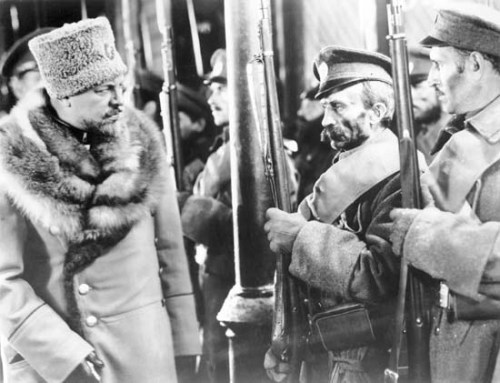The Last Command (1928)
1st Academy Awards 1929
2/5 Stars
Won Best Actor (Emil Jannings).
Watched September 12, 2012.
This film received a lot of recognition in its time, specifically for the performance of Emil Jannings, who won the first ever Best Actor award. Had I seen this performance before I had seen that of Richard Barthelmess, his running mate, I may have been more impressed. If you have seen The Last Command, you may disagree with me. He is indeed powerful and controlled, and his impassioned speech at the end of the film is wonderfully done. I almost felt a hollowness to his character, as if he was merely an actor playing a role, not the true cousin to the Czar.
The Last Command is the story of Grand Duke Sergius Alexander, “a decorated, aristocratic Czarist General [who] is reduced to penury after the collapse of Imperial Russia. An old adversary, now a successful director hires the general to re-enact the revolution which deposed him” (IMDB). The film opens as the director is going through a stack of photos and comes across that of the General. He recognizes him and tells his assistant director to call him. The Duke comes to set with a constant shake of his head, almost as if it is a symptom of Parkinsons but attributed to “a great shock” he had once. After being teased and laughed at by the extras, he looks into his makeup mirror and ironically reflects on his past.
It is the Russian Revolution. They are at war, although the General seems to see very little of it. He rides around in a nice car wearing a large fur coat and constantly smokes cigarettes. At one town, they encounter two dangerous radicals. We recognize one immediately as the director featured in the first scene. The other is a beautiful woman, Natalie Dabrova (Evelyn Brent). Typically, the General sends the director to jail and even though he is advised that Dabrova is the most dangerous of them all, he keeps her at his side and treats her as a guest.
Much of the film is spent at dinner tables or writing desks, but at the end there is a bit of action when the General’s train is overrun by activists. Here Dabrova shows her true colors, but whether it is to be a true blooded revolutionist or a love-sick woman, I will let you find out.
I like some scenes very much. From the train sequence to the end, I truly enjoyed the film and wished the best for the General. I wasn’t sure that I agreed that what happened would have put him in such a shocked state for the rest of his life, but this might be because I had difficulty connecting to his character. At the very end, when the Duke finally makes it onto set, dressed in his former General glory, and in the very same fur coat he once wore to inspect his troops and entertain the Czar, I felt a little terror regarding what the director was going to do to the man he had once wished to see hang in front of all of Russia. That being said, the very end, which I won’t give away, seemed very inconsistent with the director’s character and I felt as if the director of The Last Command wanted more to end on a positive note than to remain consistent.
This is a short, 88 minute film, so if you have been curious about silent films but haven’t wanted to commit the time, this might be a good one for you! There is history, war, romance, and killer costume design!
Sources: IMDB, Rotten Tomatoes, New York Times, SensesOfCinema
